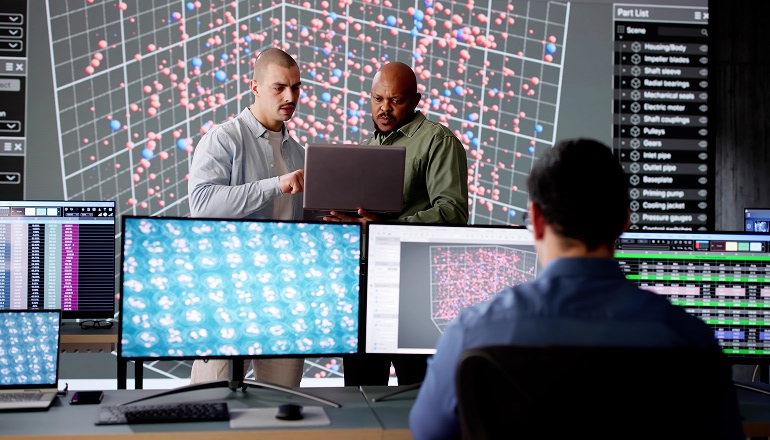Article Smooth Operations: Paving the Way for Smart City Technology
In 2016, the number of U.S. households using some kind of home automation added up to 62 million smart homes, according to a report by Statista.1 In only two years, that number climbed to 107 million smart homes. Today, the consumer market of the Internet of Things (IoT) installed base tallies 7 billion
connected things.2
By Jillian Viner / 2 Nov 2018 / Topics: Artificial Intelligence (AI) Cloud Intelligent edge

In spite of privacy concerns, the general population appears ready — and perhaps even eager — to embrace a new era of smart technology in their homes. And, if smart devices make our lives easier at home, just think what smart technology can do for an entire urban area.
So, what does a smart city look like? How does it function, and who is expected to pay for all of those expensive gadgets that make it work? And, while we’ve been quick to adopt smart things at home, why have cities been lagging behind?
But first, what is a smart city?
In short, a smart city is a connected city. It’s an ecosystem of people, devices and things communicating and collaborating. Technically speaking, a smart city uses the IoT to detect, analyze and share information that enables an urban area to operate more efficiently or improve quality of life.
The idea of technology collecting and recording data on citizens can be alarming and often raises questions of privacy and security. However, building a smart ecosystem relies on cooperation among citizens, government and private entities — and fostering greater empowerment, community engagement and social impact between citizens and governing groups.
Many smart cities have applied federal grants or private sponsorships to host resident-involved hackathon events. These competitions inspire and encourage citizens and startups to bring their innovative solutions to the table. Winning solutions can then be dropped into a pilot program for testing before large investments are made.
Smart city technology is, to a great degree, the same IoT technology we’re already experiencing in the home — but applied at a larger scale. Cloud technologies such as Microsoft Azure make these city initatives possible by providing agile, reliable and secure platforms that enable citywide connectivity.
Technologies enabling smart cities include:
- The IoT
- Sensors
- The cloud
- Artificial Intelligence (AI)
- Geospacial technology
- Blockchain
Why are smart cities needed? Or aren’t they?
The reason behind a smart city is subjective, and the mission for each smart city initiative spans a wide spectrum of problem-solving. Many smart city initiatives begin with some of our most daunting challenges as a civilization, such as:
- How do we maximize resources while reducing waste?
- How do we improve quality of life for all citizens?
- How do we build a more inclusive society?
Here are some ways the IoT is impacting cities:
Sustainability
Many smart city plans aim to maximize resources and reduce waste. Smart meters, for example, help energy companies enhance grid reliability and gain visibility over grid performance to respond quickly when issues arise.
Similarly, a self-optimizing building can improve energy efficiency by automatically turning off lights in vacant rooms, adjusting air cooling and heating to be more economical, and more. Smart cities also have a sustainability impact on waste management and water conservation.
Safety
The IoT is being applied in innovative and critical ways to improve public safety, as well. For example, sound sensors enable gunshot detection. Coupled with AI, integrated security systems can create predictive gunshot detection or real-time incident mapping and share accurate, immediate information to emergency responders and civilians.
Transportation
From dockless bicycle sharing systems for greater user convenience to smart stoplights that improve traffic flow, to dynamic public transit scheduling based on predictability models to match demand — the IoT enables an abundance of innovations in the transportation industry to make mobility easier and more efficient.
Elderly and disability services
Inclusion is a big part of the smart city conversation today — and that means ensuring accessibility goes beyond devices to encompass entire communities. The IoT and technologies such as self-driving cars can help aging populations or people with vision, hearing or other disabilities be more mobile and self-sufficient.
Why do smart cities fail?
Many challenges surround executing and sustaining a smart city because it has to be run by, well, a city. That puts the burden of management on municipalities and their elected officials. And, with a city council that’s continuously changing every few years, it’s imperative to have a strategic but flexible long-term roadmap that can adjust to shifting priorities and budgets.
 Figure 1
Figure 1
As shown in Figure 1, 63% of municipal or government entities point to budget constraints as the top obstacle for integrating smart solutions. Other top impediments include a lack of resources and expertise (35%), time constraints or other priorities (29%), and policy hurdles (28%).
Budget can be a sensitive subject even for businesses. When voters are involved, city budgets are under constant scrutiny, and there’s little room for failure. Mayors and council members have to be extra cautious — not just about how money is being spent, but also about communicating return on investment.
Insight Digital Innovation General Manager Jeff Dodge stresses that when it comes to large IoT projects, such as building out smart places, “The mission never stops. It’s a forever project. But you need to build into your project plan constant, visible wins. Set expectations and goals and show a steady stream of wins.”
As Figure 1 reveals, having adequate resources and knowledge is another hurdle cities must overcome. Launching a large-scale technology system involving the IoT is very complex. A lot can go wrong when vendors are dispersed or too many ad hoc solutions are pieced together.
To successfully launch and sustain a smart city solution, city leaders should find a trusted partner who can guide them through the entire process, including visioning, vendor management, supply chain and ongoing support — especially through the inevitable change management of city leaders.
Rome wasn’t built in a day.
Smart cities have been on the lips of technology enthusiasts and futurists for years. And, while we’re seeing growing interest in these communities of tomorrow, the reality of these intelligent places will be a slow and steady process.
“Don’t just keep throwing puzzle pieces on the floor and hope it looks good,” says Dodge. “From a data perspective, have some sort of framework and architecture so those pieces come together in a beautiful picture.”
Developing a smart city begins with smaller, bit-sized IoT initiatives. Each solution is a data science experiment that progressively builds on another and continues to create more clean, manageable and manipulatable data. From there, cities can scale projects to run bigger, more robust and repeatable experiments and deliver more actionable insights.
There’s no shortage of problems to solve — and infinite ways the IoT can be applied to solve them. The technology is here. The question is, how do we implement it? City leaders today are faced with tremendous obstacles — and even greater opportunities. They just have to get started.
1 Statista. (September 2018). Statista Digital Market Outlook: Smart Home Worldwide.
2 Statista. (2018). The Internet of Things (IoT) Units Installed Base by Category From 2014 to 2020. Statista.com.







